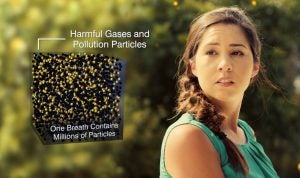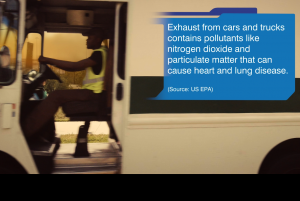
By Sarah Vogel, Ph.D., VP Health
When we’re outside, either walking or driving, we’re instinctively looking out for traffic. “Look both ways when you cross the street,” is advice drummed into most children.
But even so, we all have blind spots, and we’re not aware of the present danger polluting cars and trucks bring into our daily lives.
Our new video shows that although air pollution from vehicle exhaust is invisible, its damage to our health is visible and deadly.
EDF’s Global Clean Air Initiative has spent years researching air pollution in cities around the world. Our pioneering work with Google Earth Outreach, academic, community and government partners in Oakland, Houston and London shows that levels of air pollution vary much more widely than was previously known. In Oakland, we now know that levels of air pollution can vary by up to eight times within one city block. We’ve been working to visualize local pollution and its impacts in order to support targeted policies for cleaner air especially in those communities hardest hit by pollution. But we also recognized the need to make the experience of pollution more visible and more personal to each one of us as we walk down a city street.
Animated Reality Video based on EDF data
We developed a new animated reality video showing the path that pollution takes from tailpipe into the body. Our video was shot in a location in Houston, Texas, in a residential community that lies adjacent to a major freeway where EDF measured high levels of particulates and nitrogen dioxide (NO2) in our 2017-2018 hyperlocal air quality monitoring study, and where the residents experience elevated rates of adult asthma, chronic obstructive pulmonary disease, heart disease, and stroke compared to other neighborhoods in the city.
The video begins with a drone video shot gliding over a busy highway, where the pollution coming from cars and trucks is shown as a half-pipe expanding in 3D. The camera then focuses on a mother and her daughter (both actors) walking down a street–we follow them as they pass trucks and are engulfed in animated pollution particles from exhaust emissions.

Millions of pollution particles in each breath
Pollution is animated as yellow waves of pollution simulating swirling gases, and small, black and yellow animated dots to represent microscopic particles of pollution. According to Adam Nieman of Real World Visuals who worked on this project, a single breath at East Loop South in Houston may contain 18 million particles.1
“The number of particles per breath varies by location and the proximity to different sources of air pollution,” Ramon Alvarez, EDF’s associate chief scientist notes. Regardless of the precise location in an urban area, most people are unaware they can be breathing in millions of pollution particles with each breath.”
Health risks of pollution from transportation
In the video, the animated pollutants travel from tailpipe to trachea, and deep into the young girl’s lungs. EDF epidemiologist Maria Harris shared, “Even short-term exposure to diesel exhaust can cause health impacts, including headaches, dizziness, and eye, nose and throat irritation. Regular exposure to diesel exhaust over time can cause lung cancer, as well as heart disease and other respiratory diseases. Children, whose lungs are still developing, are especially at risk for the respiratory impacts of diesel exposure. Seniors or others with chronic health issues are also at higher risk for respiratory and cardiovascular effects.”
To reduce diesel exposure, Harris suggests trying to limit time walking, biking, or driving on roads with heavy diesel truck or bus traffic, and avoiding areas where diesel trucks or buses idle.
But if we are to build healthy and resilient communities, we need to dramatically cut the emissions from the burning of oil and gas used in transportation, especially cars and trucks.
Benefits for health and climate
In addition to producing harmful air pollution, cars and light trucks account for about 45 percent of all U.S. oil consumption and more than 20 percent of all U.S. greenhouse gas emissions.
Globally, climate emissions from large vehicles are on pace to double in the next 30 years. To reverse this trend and transform large vehicles into a critical part of a 100% clean economy, the global fleet must complete a near-total transition to zero-emission trucks and buses.
Electric trucks can help protect driver’s health
Every day, trucks and buses carry the goods, packages and people that keep our economy running. Usually powered by diesel engines, they are among the dirtiest vehicles on the road.
In the video, the actor portraying a delivery driver is exposed to the invisible pollution. Truck drivers often have high occupational exposure to diesel exhaust, which may put them at elevated risk of lung cancer and cardiovascular and respiratory disease. Cabin air filtration systems can help reduce diesel exposure for truck drivers. But ultimately, the best approach for protecting drivers and the communities they drive through is to shift to electric trucks and buses.
With electric vehicles, a zero-emission future that benefits the environment, people and economy is possible.
Take Action for Healthier Solutions
Now that you’ve seen how dangerous air pollution is to our health, we invite you to join the virtual community assembled at GlobalCleanAir.org and help us bring cleaner air to communities around the world. Also, we hope you join the global conversation about public health and clean air on Twitter @EDFCleanAir.
On the site you’ll learn about the health impacts of different air pollutants, case studies on innovative air quality monitoring across the world, tools to implement community-wide strategies where you live, and tips we can all take to clean the air we breathe. We encourage you to visit, and sign up for our monthly newsletter and advocacy action alerts.
Video Script and Sources
Below are facts cited in the video script, listed with links to their sources.
What if invisible pollution became visible?
1. Around the world, nine out of 10 people breathe unhealthy air. (Source: World Health Organization)
2. FACTOID: Exhaust from [diesel and gasoline] cars and trucks contains pollutants like nitrogen dioxide and particulate matter that can cause heart and lung disease. (Source: US EPA)
3. FACTOID: With every breath, a person on this street will inhale harmful gases and millions of tiny particles. (Source: EDF)
4. FACTOID: Particulates can penetrate deep into the lungs and even enter the bloodstream. Nitrogen dioxide can inflame airways and cause asthma attacks. (Source: American Lung Association)
5. FACTOID: About 4 million children worldwide develop asthma each year from breathing nitrogen dioxide. (Source: George Washington University)
6. Air pollution can cross the placenta and may harm babies’ brain development. (Source: Project TENDR)
Air pollution is invisible, but it damages our health and is sometimes deadly.
Healthier solutions are here.
1.The pollution particle count in the EDF Houston data (near the East Loop South highway) was 36,000 particles per cubic centimeter. The average ‘tidal volume’ of an adult breath is 0.5 litres, which means that a single breath at East Loop South would contain about 18 million pollution particles.

